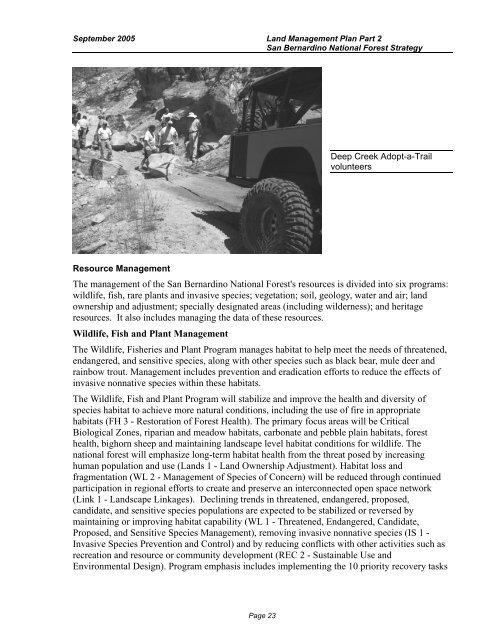San Bernardino National Forest Land Management Plan - Part 2
San Bernardino National Forest Land Management Plan - Part 2
San Bernardino National Forest Land Management Plan - Part 2
Create successful ePaper yourself
Turn your PDF publications into a flip-book with our unique Google optimized e-Paper software.
September 2005 <strong>Land</strong> <strong>Management</strong> <strong>Plan</strong> <strong>Part</strong> 2<br />
<strong>San</strong> <strong>Bernardino</strong> <strong>National</strong> <strong>Forest</strong> Strategy<br />
Resource <strong>Management</strong><br />
Deep Creek Adopt-a-Trail<br />
volunteers<br />
The management of the <strong>San</strong> <strong>Bernardino</strong> <strong>National</strong> <strong>Forest</strong>'s resources is divided into six programs:<br />
wildlife, fish, rare plants and invasive species; vegetation; soil, geology, water and air; land<br />
ownership and adjustment; specially designated areas (including wilderness); and heritage<br />
resources. It also includes managing the data of these resources.<br />
Wildlife, Fish and <strong>Plan</strong>t <strong>Management</strong><br />
The Wildlife, Fisheries and <strong>Plan</strong>t Program manages habitat to help meet the needs of threatened,<br />
endangered, and sensitive species, along with other species such as black bear, mule deer and<br />
rainbow trout. <strong>Management</strong> includes prevention and eradication efforts to reduce the effects of<br />
invasive nonnative species within these habitats.<br />
The Wildlife, Fish and <strong>Plan</strong>t Program will stabilize and improve the health and diversity of<br />
species habitat to achieve more natural conditions, including the use of fire in appropriate<br />
habitats (FH 3 - Restoration of <strong>Forest</strong> Health). The primary focus areas will be Critical<br />
Biological Zones, riparian and meadow habitats, carbonate and pebble plain habitats, forest<br />
health, bighorn sheep and maintaining landscape level habitat conditions for wildlife. The<br />
national forest will emphasize long-term habitat health from the threat posed by increasing<br />
human population and use (<strong>Land</strong>s 1 - <strong>Land</strong> Ownership Adjustment). Habitat loss and<br />
fragmentation (WL 2 - <strong>Management</strong> of Species of Concern) will be reduced through continued<br />
participation in regional efforts to create and preserve an interconnected open space network<br />
(Link 1 - <strong>Land</strong>scape Linkages). Declining trends in threatened, endangered, proposed,<br />
candidate, and sensitive species populations are expected to be stabilized or reversed by<br />
maintaining or improving habitat capability (WL 1 - Threatened, Endangered, Candidate,<br />
Proposed, and Sensitive Species <strong>Management</strong>), removing invasive nonnative species (IS 1 -<br />
Invasive Species Prevention and Control) and by reducing conflicts with other activities such as<br />
recreation and resource or community development (REC 2 - Sustainable Use and<br />
Environmental Design). Program emphasis includes implementing the 10 priority recovery tasks<br />
Page 23
















